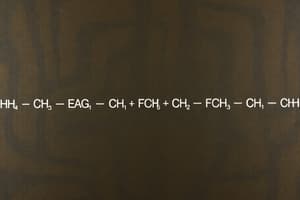Podcast
Questions and Answers
What is the role of a reactant in a chemical reaction?
What is the role of a reactant in a chemical reaction?
- It remains unchanged throughout the reaction.
- It is always a gas.
- It is consumed during the reaction. (correct)
- It is formed after the reaction.
How are diatomic molecules represented in their chemical equations?
How are diatomic molecules represented in their chemical equations?
- By their elemental name.
- By their chemical formula with a subscript of 2. (correct)
- By combining their atomic numbers.
- By single letters.
In the equation 2H2 + O2 → 2H2O, what is the product of the reaction?
In the equation 2H2 + O2 → 2H2O, what is the product of the reaction?
- H2 and O2
- H2
- O2
- H2O (correct)
Which symbol is typically used to separate reactants and products in a chemical equation?
Which symbol is typically used to separate reactants and products in a chemical equation?
What forms when hydrogen gas combusts in the presence of oxygen?
What forms when hydrogen gas combusts in the presence of oxygen?
When writing a chemical equation, where are the reactants located?
When writing a chemical equation, where are the reactants located?
What is represented by the number in front of a chemical formula in a balanced equation?
What is represented by the number in front of a chemical formula in a balanced equation?
Which of the following is a diatomic molecule?
Which of the following is a diatomic molecule?
What is the purpose of using the stock system when naming transition metals?
What is the purpose of using the stock system when naming transition metals?
In the stock system, how is the oxidation number of a metal indicated?
In the stock system, how is the oxidation number of a metal indicated?
Which of the following names is correctly associated with its formula using the Latin naming system?
Which of the following names is correctly associated with its formula using the Latin naming system?
What prefix is used to denote the presence of three atoms of a nonmetal in a covalent compound?
What prefix is used to denote the presence of three atoms of a nonmetal in a covalent compound?
Which of the following correctly describes the naming convention for binary covalent compounds?
Which of the following correctly describes the naming convention for binary covalent compounds?
If a nonmetal combines with a nonmetal, what type of bond is generally formed?
If a nonmetal combines with a nonmetal, what type of bond is generally formed?
What is the correct name for Cu^+2^ O^-2^ in both naming systems?
What is the correct name for Cu^+2^ O^-2^ in both naming systems?
When determining the formula for covalent compounds, which element is named first?
When determining the formula for covalent compounds, which element is named first?
In a single-displacement reaction, what determines which element will be displaced?
In a single-displacement reaction, what determines which element will be displaced?
What is the general form of a double-displacement reaction?
What is the general form of a double-displacement reaction?
Which of the following reactions is an example of a single-displacement reaction?
Which of the following reactions is an example of a single-displacement reaction?
Which of the following statements about the activity series is incorrect?
Which of the following statements about the activity series is incorrect?
What occurs during a neutralization reaction?
What occurs during a neutralization reaction?
In which scenario would a double-displacement reaction take place?
In which scenario would a double-displacement reaction take place?
Which reaction best represents a nonmetal displacing another nonmetal in a double-displacement scenario?
Which reaction best represents a nonmetal displacing another nonmetal in a double-displacement scenario?
What role does zinc play in the reaction Zn + NiSO4 → ZnSO4 + Ni?
What role does zinc play in the reaction Zn + NiSO4 → ZnSO4 + Ni?
What observation indicates the production of mercury while heating mercury(II) oxide?
What observation indicates the production of mercury while heating mercury(II) oxide?
What is the first step in balancing a chemical equation?
What is the first step in balancing a chemical equation?
In the unbalanced equation H2(g) + O2(g) → H2O(l), how many oxygen atoms are on the reactant side?
In the unbalanced equation H2(g) + O2(g) → H2O(l), how many oxygen atoms are on the reactant side?
What adjustment is needed to balance the equation H2(g) + O2(g) → H2O(l)?
What adjustment is needed to balance the equation H2(g) + O2(g) → H2O(l)?
After placing a '2' in front of H2O, what is the total number of hydrogen atoms on the product side?
After placing a '2' in front of H2O, what is the total number of hydrogen atoms on the product side?
Why is it important to use the smallest whole number coefficients when balancing equations?
Why is it important to use the smallest whole number coefficients when balancing equations?
What should be placed before H2 in the equation H2(g) + O2(g) → 2 H2~O(l) to achieve balance?
What should be placed before H2 in the equation H2(g) + O2(g) → 2 H2~O(l) to achieve balance?
Which of the following statements about balancing chemical equations is true?
Which of the following statements about balancing chemical equations is true?
What is the balanced equation for the reaction involving sodium and sulfur?
What is the balanced equation for the reaction involving sodium and sulfur?
How can you ensure accurate balancing of a chemical equation?
How can you ensure accurate balancing of a chemical equation?
Which statement best describes the Law of Conservation of Matter?
Which statement best describes the Law of Conservation of Matter?
In chemical formulas, how should the overall charge be balanced?
In chemical formulas, how should the overall charge be balanced?
What type of chemical reaction occurs when one compound breaks down into two or more simpler products?
What type of chemical reaction occurs when one compound breaks down into two or more simpler products?
Which prefix is used to indicate three atoms of an element in a covalent compound?
Which prefix is used to indicate three atoms of an element in a covalent compound?
What is an example of a double-displacement reaction?
What is an example of a double-displacement reaction?
Which of the following correctly represents how to balance the equation NaHCO3 + H2SO4 → Na2SO4 + CO2 + H2O?
Which of the following correctly represents how to balance the equation NaHCO3 + H2SO4 → Na2SO4 + CO2 + H2O?
Study Notes
Writing Chemical Formulas
- Transition metals can have variable oxidation numbers, meaning they can form compounds with different charges.
- The stock system uses Roman numerals in parentheses to indicate the oxidation number of the metal.
- The Latin naming system uses suffixes -ous and -ic to denote the lower and higher oxidation states, respectively.
- Compounds formed from two nonmetals use prefixes to indicate the number of atoms of each element.
- Greek prefixes are used to name covalent compounds:
- mono- 1
- di- 2
- tri- 3
- tetra- 4
- penta- 5
- hexa- 6
- hepta- 7
- octa- 8
- nona - 9
- deca - 10
Chemical Equations
- A chemical equation is a shorthand representation of a chemical reaction.
- It shows the reactants on the left side and products on the right side, separated by an arrow.
- Symbols used in chemical equations:
- → indicates the reaction proceeds in one direction
- ⇌ indicates the reaction is reversible
- (g) gas
- (l) liquid
- (s) solid
- (aq) aqueous solution
- Diatomic molecules are made up of two atoms of the same element.
- Diatomic molecules include:
- hydrogen (H2)
- nitrogen(N2)
- oxygen(O2)
- fluorine (F2)
- chlorine(Cl2)
- bromine(Br2)
- iodine (I2)
Balancing Chemical Equations
- Balancing chemical equations ensures that the number of atoms of each element is the same on both sides of the equation, adhering to the Law of Conservation of Mass.
- The coefficients in front of each chemical formula are adjusted to achieve balance.
- Steps for balancing chemical equations:
- Identify reactants and products with their correct formulas.
- Write the unbalanced equation.
- Balance the equation by adjusting coefficients in front of each formula.
- Ensure the smallest whole number coefficients are used.
Types of Chemical Reactions
- Combination Reaction: Two or more reactants combine to form a single product.
- Decomposition Reaction: A single reactant breaks down into two or more products.
- Single-Displacement Reaction: An element replaces another element in a compound.
- The electromotive or activity series is a list that shows the order of reactivity of metals and nonmetals.
- Metals higher in the list can displace metals lower in the list.
- Double-Displacement Reaction: Two compounds exchange ions, forming two new compounds.
- Also called metathesis or double replacement.
Naming Compounds
- Binary Ionic Compounds:
- The more positive (metallic) element is named first.
- The more negative (nonmetallic) element is named second with the suffix -ide.
- Polyatomic Ionic Compounds:
- The name of the cation is followed by the name of the anion.
- Polyatomic ions often end in -ate or -ite, with -ite indicating a lower oxygen content.
- Covalent Compounds:
- Use prefixes (mono, di, tri, etc.) to indicate the number of atoms of each element in their respective formulas.
- The prefix mono- is only used for the second element if only one atom is present.
Studying That Suits You
Use AI to generate personalized quizzes and flashcards to suit your learning preferences.
Related Documents
Description
This quiz covers the essential concepts of writing chemical formulas and equations. It includes topics like oxidation numbers, naming conventions for compounds, and the structure of chemical equations. Test your understanding of these fundamental principles in chemistry!




